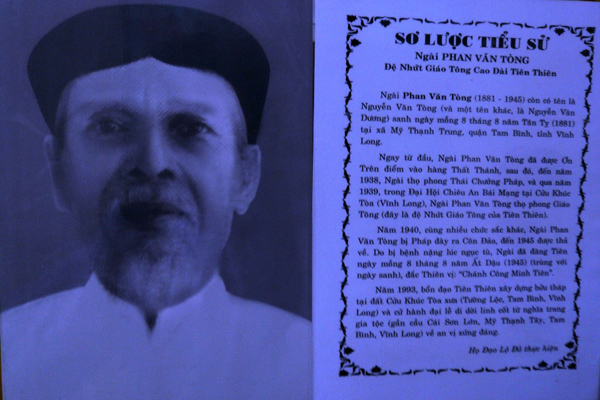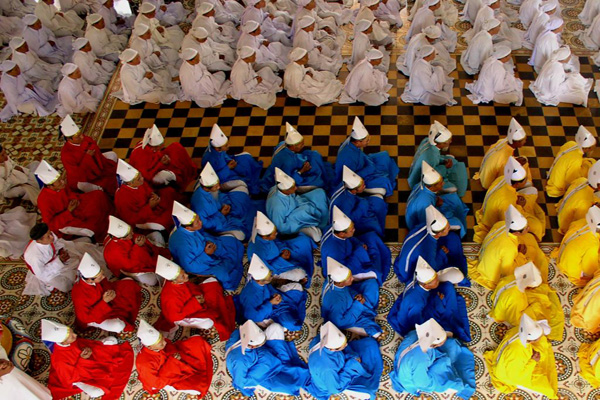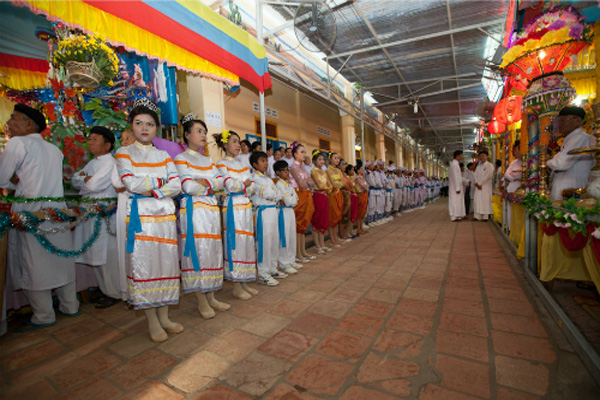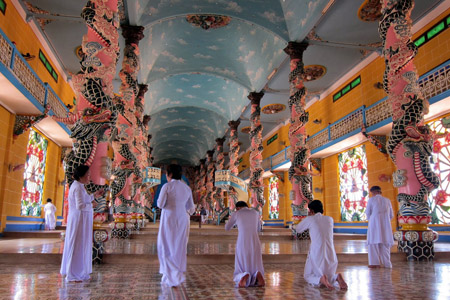During the period 1926-1934, Caodaism promoted its missionary work to increase its members, mainly in Vietnam, Cambodia, and some other countries.
South Vietnam was the key area in which missionary work was promoted. Here, Caodaist dignitaries both honored Caodaism as a “national religion,” which is imbued with patriotism, and exploited thoroughly the magic of Co but to attract followers. They especially focused on converting landlords, officers, and intellectuals to this religion. These converted people would later be promoted to the positions of dignitaries so that they would help to promote Caodaism and attract people who were under them to follow the religion. They included Nguyen Van Ca (from My Tho), Phan Van Tong (from Vinh Long), Cao Trieu Phat (from Bac Lieu), and Vo Van Tam (from Can Tho). They contributed to increasing the number of Caodaism followers in the Mekong River Delta. The considerable increase of Caodaism followers in South Vietnam during this time was partly due to the participation of former supporters and members of the South Vietnam Secret Society, as well as former followers and dignitaries of Ngu Chi Minh Dao. Particularly in the Sai Gon – Cho Lon area, Caodaism was also supported by many officials, intellectuals, social activists, and especially leaders of the Lap Hien movement such as Bui Quang Chieu, Nguyen Phan Long, and Duong Van Giao.

Initially, Caodaism was criticized by some intellectuals and dignitaries of other religions. In the late 1920s and early 1930s, the debate over Caodaism was very heated with intellectuals and monks (such as Nguyen Tu Thuc, Tran Huy Lieu, Dao Trinh Nhat, Nguyen An Ninh, and the Most Venerable Thai Dien) adding their objections to this new religion. However, by the late 1930s, as a consequence of the Caodaist leaders’ refusal to be drawn into this debate, as well as the complicated socio-economic situation in South Vietnam that attracted the attention of social forces, debates over Caodaism decreased and finally ended.
Caodaism would have been kept under tight control by the French during this time without its great clash with the national culture and beliefs. In reality, the French colonial administration initially did not have any doubt about Caodaism. Instead, they were sympathetic toward it since they thought that it was close to Spiritism in Europe and that its followers included mainly landlords, bourgeoisie, officials, and intellectuals. However, they started to be concerned about it when Caodaism developed beyond their control and showed the signs of secret political activities. As a result, they began to distrust Caodaism and heightened their vigilance. During 1926-1927, the French administration imposed some measures to slow down the development of Caodaism. From 1929 to 1931, Caodaism expanded its influence to 18 out of 20 provinces in South Vietnam with hundreds of thousands of followers. In addition, the people endured many struggles, especially peasants, under the leadership of the Indochinese Communist Party in many places in Vietnam. This resulted in the French administration implementing firm policies against Caodaism. Some temples were forced to close; some seances were canceled; some Caodaist dignitaries were arrested or put under surveillance.
The leaders of Caodaism applied clever measures to cope with that situation. On the one hand, they carried out both secret and public activities. On the other hand, they dealt gently with the French authorities to appease them. They also took advantage of dignitaries who held high positions of authority and those who came from high classes in society to persuade the French authorities to adopt open policies toward Caodaism. By that time, some French scholars and officials such as Louis Mattry, Coulet, Vilmont, and La Laurette had carried out studies and made reports to the French authorities to further their understanding of Caodaism. As a result, in late 1932, the French authorities implemented open policies toward Caodaism. However, it was not until 1935 when the French Democratic Front rose to power that changes were made in the colonial policy. Moreover, the democratic movement (1936-1939) in Vietnam led by the Indochinese Communist Party achieved important successes. Thanks to these, Caodaism could return to normal.
Caodaism was spread to Central and North Vietnam later than the South-in the late 1920s and early 1930s. Although missionary activities in Central Vietnam were not hindered by traditional religions and beliefs, they failed because the French protectorate and Southern government had put a ban on Caodaism there. It is stated clearly in the Royal Decree No. 10 adopted by King Bao Dai that, “Caodaism is strictly banned from spreading in Central Vietnam.” Public, organizational missionary activities were not successful whereas, secret, individual missionary organizations were still maintained and achieved certain successes in such provinces as Quang Nam, Quang Ngai, Binh Dinh, and Phu Yen. Thanks to this, two Caodaist sects were later established in this region, the Caodaist Missionary Church (Hoi thanh Truyen giao Cao Dai) and Cau Kho Tam Quan Caodaist Church (Hoi thanh Cao Dai cau Kho Tam Quan) in Binh Dinh. Caodaism was propagated in the North publicly since the French authorities were less strict there. Nevertheless, Caodaism, on the one hand, found it hard to fall in line with the local lifestyle, culture, and beliefs. On the other hand, it was divided into sects in its early introduction here, so it achieved restricted outcomes. Accordingly, there were only several groups of Caodaism followers scattered in Hanoi, Ha Tay, and Hai Phong.

Soon after its establishment in Tay Ninh, Caodaism received support from the Khmer ethnic group. Rumors circulated that a prince on the white horseback who saved the Khmer ethnic was in Tay Ninh. Subsequently, many people made pilgrimages to Tay Ninh, up to 30,000 in 1927. In this situation, the Royal Government of Cambodia implemented strict measures to prevent the flow of Khmer people from going to Tay Ninh for Caodaism. The Khmer were torn between their loyalty to the Royal family and their new religion. Furthermore, after realizing the differences between Caodaism and their traditional religion, they stopped their pilgrimages and gradually gave it up. Later, there were only a small number of Vietnamese Caodaist followers in Cambodia.
In this period, Caodaism tried to expand its activities into Germany, America, China, and some other countries. However, it hardly gained any success.
In summary, from its birth to the mid-1930s, Caodaism made many efforts to expand its influence. It developed rapidly in the South for many economic, cultural, social, and ideological reasons. This helped it assert its position as a real religion there. However, it was hardly successful in Central and North Vietnam.
When it was established, Caodaism was a unified religion with its nervous center in Tay Ninh Holy See. However, after a short time, it split into many sects. As a rule, any religion that develops to a certain level eventually differentiates. While other religions split for differences in doctrinal and spiritual viewpoints, Caodaism split due to individual conflicts among dignitaries.

Caodaism exposed internal conflicts soon after its establishment. However, it was not until 1934 that it was officially divided into sects. That year, two high dignitaries, Nguyen Ngoc Tuong and Le Ba Trang left the Tay Ninh Holy See for Ben Tre to establish Ban Chinh Dao Caodaism (Cao Dai Ban Chinh dao) for their divergences with Le Van Trung and Pham Cong Tac in the management of the Holy See. During the period of 1930- 1940, Caodaism was divided into sects that are still currently in operation without any changes.
To understand the development of Caodaism, it is necessary to provide some data courtesy of published documents. At its inauguration in late 1926, Caodaism had 50 thousand followers and 31 places of worship. A year later, the number of its followers was reported by Caodaist dignitaries to reach nearly 300,000, which was more than that of Catholic followers in the South after nearly 300 years of evangelization. It was written in Lich su Cao Dai (History of Caodaism) by Dong Tan that there were 350,000 Caodaist followers and 106 places of worship in 1931. According to S. Wenner, there were nearly 500,000 Caodaist followers in South Vietnam while its population at that time was just 4.5-5 million people in 1934. According to unofficial statistics, there were around 2 million Caodaist followers in 1954 and nearly 3 million in 1975. According to a recent survey by the Vietnamese Vietnam Government Committee for Religious Affairs, in 2003, there were 2.3 million Caodaist followers; 7,380 dignitaries; and 1,208 temples and religious bases in 34 provinces and cities in Vietnam.



